Bunk management as a strategy requires time and the attention of feedlot operators but when executed effectively, bunk management practices can pay dividends in the form of improved efficiencies and cattle performance. ‘Bunk management’ is essentially matching feed deliveries with feed intakes to optimize performance, but in practice there are many aspects of bunk management that lend to better health and performance in cattle. Good bunk management practices help to address differing risks along the feeding continuum for feedlot cattle.
During the finishing phase where cattle are typically fed a high-grain ration, any disturbance in feed intake can result in cattle “stalling out”. At this stage, bunk management plays a role in keeping cattle consistently on feed, reducing risk of digestive disorders, achieving desired gains, and reducing feed waste. A 2020 bunk management project jointly coordinated by the Ontario Corn Fed Beef Program (OCFBP) and OMAFRA demonstrated the impacts of bunk management on feeding behaviour in finishing cattle. This work highlighted the importance of understanding the length of time the feed bunk is empty, consistency in daily feeding activities, assessing bunk scores (feed disappearance) and pushing up feed as bunk design necessitates. Figure 1 provides an example of the impact of feeding activities on feeding behaviour in finishing cattle while Figure 2 demonstrates the consistency of feeding behaviour over the course of a number of days where the bunk is managed effectively for finishing cattle. A more detailed overview of study outcomes can be found in Ontario Beef (August 2021) and Virtual Beef (Spring Edition 2021).
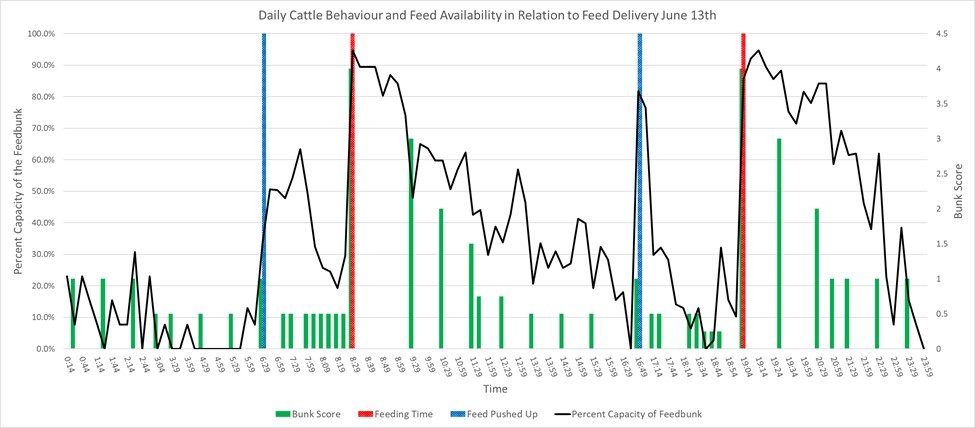
Figure 1. Feeding behaviour and bunk score over time, where time “0” is midnight.

Figure 2. Number of cattle at the feed bunk (expressed as a percent of the capacity of the feed bunk) over three days (each line representing a different day). Time “0” represents time of morning feeding.
Bunk management is also an important management strategy for newly received cattle. Getting cattle onto feed when they arrive and maintaining intakes are markers of a successful receiving program. Newly received cattle come with a distinct set of challenges: these cattle are transitioning to a new ration (where the previous ration may or may not be known to the feedlot operator), are adapting to a new environment, and have recently experienced some level of stress during transportation and commingling. If they are lighter calves, they also may have been recently weaned and are unfamiliar with a feed bunk. Every group of cattle arriving at the feedlot is unique, including their feed intake patterns when they arrive at the feedlot. Environmental conditions and preconditioning programs prior to cattle arriving at the feedlot play a big role in determining how incoming cattle will adapt to the feedlot. When coupled with a good health program and setting up pens with plenty of fresh bedding and drinking water, bunk management strategies can help mitigate risks of setbacks when getting cattle started on feed.
Bunk management strategies for newly received cattle
As part of continued bunk management work coordinated by the OCFBP and OMAFRA in 2021, bunk management strategies applied to newly received cattle and associated cattle behaviours were tracked on participating Ontario feedlots. The starting weights of these cattle ranged between 725-1000 lbs. Some common practices between feedlot participants that lead to desired feeding outcomes are described below.
Attentiveness to the bunk – avoiding long periods of empty bunks
We often discuss consistency in timing of feeding as being one of the tenets of good bunk management. Scheduling feed deliveries during the shoulders of the day allows for other farm activities or off-farm work to be completed, however, these feed delivery times also match the biphasic feeding behaviours of cattle, where cattle naturally tend to increase their feeding activity early-mid morning and later afternoon. Cattle are creatures of habit and therefore consistency in feeding is key. Having routine feeding times also allows for more accurate and effective assessment of dry matter intake (i.e. ‘reading bunks’), particularly in slick-bunk programs where the goal is to feed cattle to appetite without running empty bunks for too long (more than 1-2 hours before next feeding).
Considering every group of cattle coming into the feedlot have unique needs, feed deliveries may need to be adjusted for newly received cattle as they get settled into the feedlot. A prime example of this is cattle coming off depleted pasture and into the feedlot with little ‘gut fill’. This was demonstrated well at one of the participating feedlots. The dry matter intake of this group of cattle was much higher than anticipated which necessitated additional feed deliveries to keep cattle on feed (see Figure 3a-b).

Figure 3a. Feeding behaviour and feed disappearance one day following cattle arrival at the feedlot, arriving from drought pasture
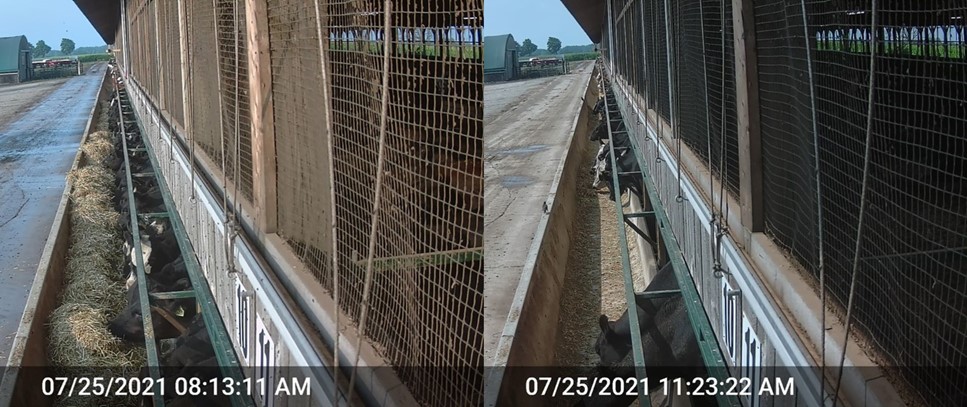
Figure 3b. Trail cam images showing the rapid feed disappearance for this group of newly received cattle. The image on the left shows the bunk with full feed after morning feeding and the image on the right shows feed depleted within a few hours.
Careful observation of the feed bunk throughout the first days after receiving was critical to keep feed in front of cattle. Smaller, more frequent feedings while cattle adjusted to the feedlot helped to strike a critical balance between under and over-feeding in this scenario. Heightened awareness and frequent assessment of cattle feeding behaviour in the first couple of days after receiving is a best practice in any feeding situation so that adjustments in feeding activities can be made according to the unique behaviours of each group of cattle.
Starting cattle on a high roughage rations with step-up transitions
Participating feedlots either started cattle on dry hay and transitioned cattle to a high-roughage TMR or started cattle directly on a high-roughage TMR. The benefit of offering cattle dry hay and/or a high-roughage TMR upon arrival is that it attracts cattle to the bunk and encourages feed intake. A high roughage ration provides ‘gut fill’ to prevent hungry, newly received cattle from gorging at the bunk. Younger cattle may not yet be adjusted to fermented feeds and offering a long-stemmed dry hay while slowly introducing the starter ration helps them to transition to fermented feeds. Feeding a high-grain ration at this stage can lead to digestive upsets and off-feed occurrences, whereas a step-up approach starting with a dry hay or high forage ration can help achieve a smooth transition to higher starch levels in the feed as well as a steady climb in intakes.
Working with a nutritionist is necessary to formulate appropriate receiving rations with adequate forage inclusion. Figure 4 shows typical forage levels in diets of newly received cattle, as reported by Ontario feed industry professionals (ON Beef Feedlot Feed Industry Survey, 2021). Physically effective fibre levels of the ration can also be measured using the % NDF from your feed analysis and a Penn State Particle Separator, where the top two sieves of the shaker box are used for calculating the physically effective factor (pef) for feedlot rations. Physically effective NDF (peNDF) is calculated by multiplying pef by % NDF. The peNDF of the starter rations in the farms profiled in this project ranged from 26%-30%. By comparison, previous benchmarking work in Ontario (Wood and Van Schaik, 2018) showed the average peNDF for finishing rations was 7.9%, which is too low to ensure rumen health.

Figure 4. Typical forage levels in diets of newly received cattle, as reported by Ontario feed industry professionals (ON Beef Feedlot Feed Industry Survey 2021)
How dry hay is provided to newly received cattle depends on pen infrastructure and feeding capabilities. Some cattle feeders will use the feed bunk for both dry hay delivery as well as for introducing the starter ration, while others will use a separate manager to offer cattle free-choice hay and transition cattle from dry hay to a TMR. Figures 5a-c and 6 show the evolution of feeding behaviour when cattle are offered dry hay in feeders (orange bars) and TMR in a feed bunk (blue bars). Interestingly, cattle explored the main TMR feed bunk before the first TMR feeding on day 1 (relative to arrival), and between days 1 and day 3 there is a visible transition from predominantly dry hay-feeding to predominantly TMR-feeding.
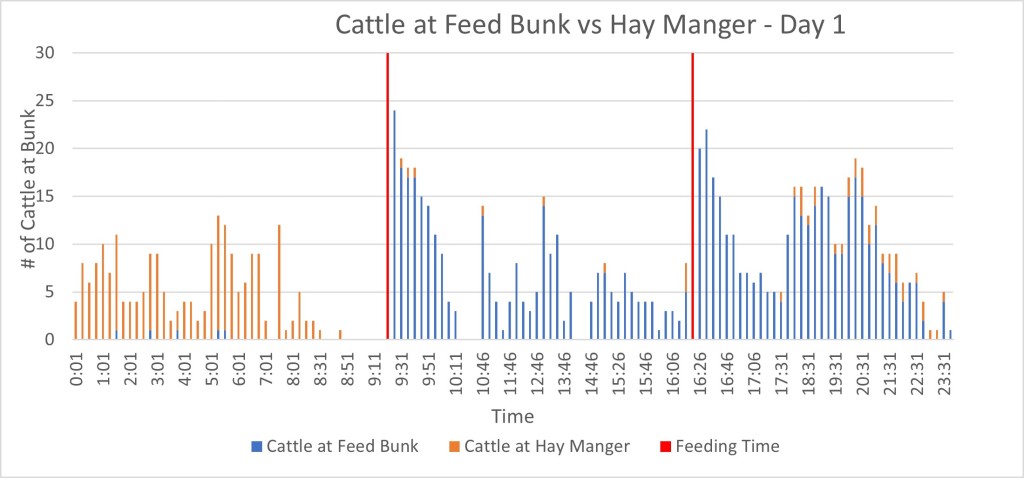
Figure 5a. Feeding behaviour one day after cattle at the feedlot, where the orange bars represent cattle feeding at the hay manger and the blue bars represent cattle feeding at the TMR feed bunk. The first TMR offering occurred at approximately 9:15 am on Day 1.
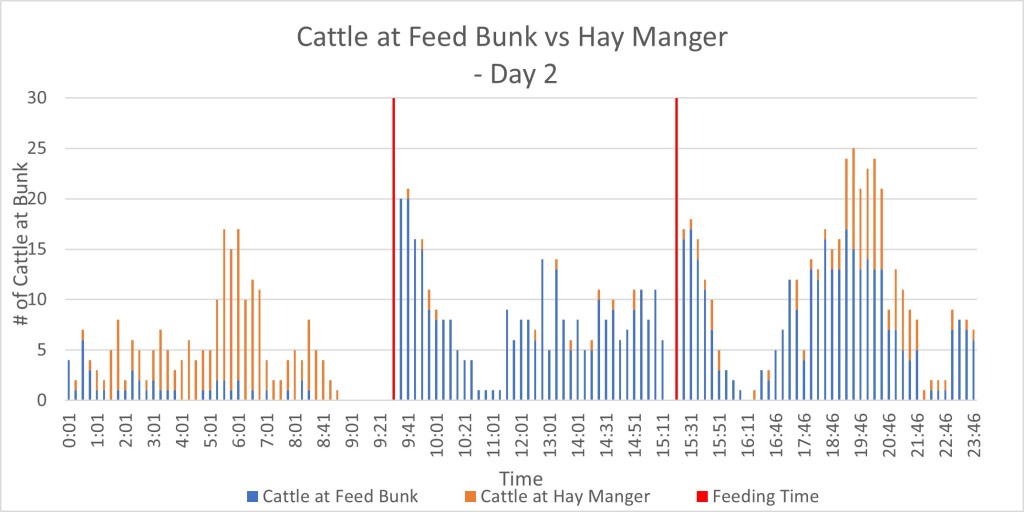
Figure 5b. Feeding behaviour two days after cattle arrived at the feedlot, where the orange bars represent cattle feeding at the hay manger and the blue bars represent cattle feeding at the TMR feed bunk
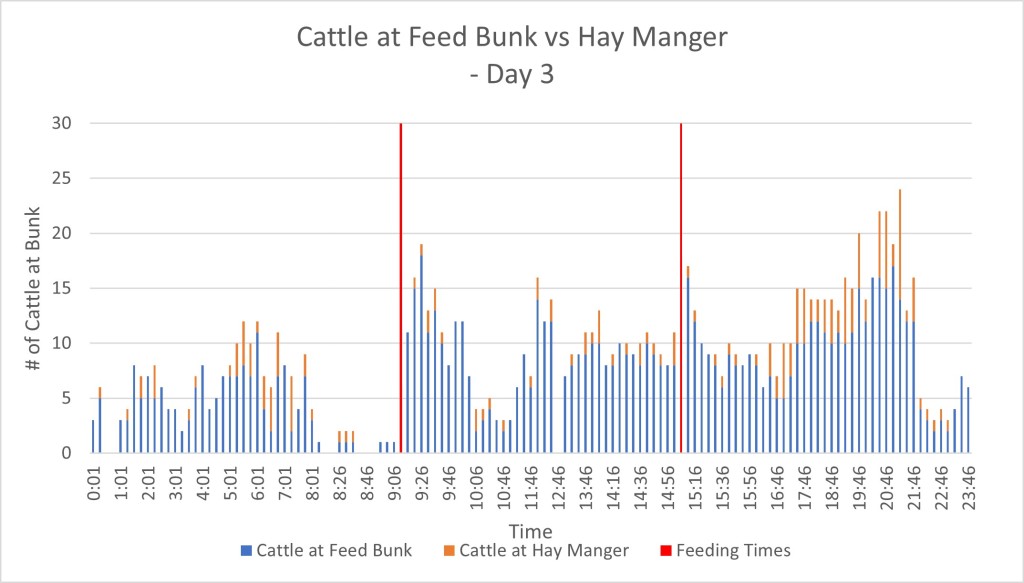
Figure 5c. Feeding behaviour three days after cattle arrived at the feedlot, where the orange bars represent cattle feeding at the hay manger and the blue bars represent cattle feeding at the TMR feed bunk
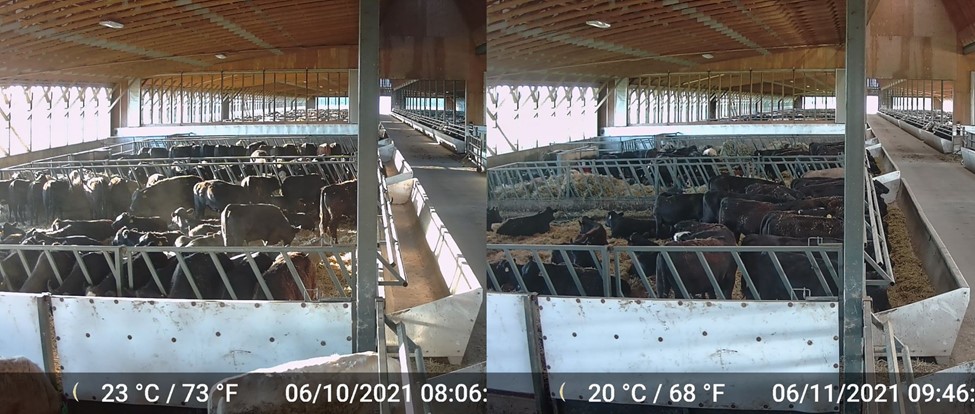
Figure 6. Trail camera images showing dry hay feeding from hay mangers (left) for the first 24 hours after receiving and cattle transitioning from dry hay feeding to TMR feeding at the feed bunk (right).
Applying other best practices
Other best practices that cattle feeders applied as part of their receiving program included:
- Limiting the time during which bunks were empty as part of slick bunk management
- Practicing consistent feeding times when cattle became adjusted to the feedlot
- Adopting 2x/day feeding when cattle became adjusted to the feedlot
- Allowing bunk access to cattle at all times
Take-aways for feedlots
Receiving new cattle can be one of the most challenging phases in the feeding period. Getting cattle onto feed and maintaining intake is an important aspect of a receiving program and the implementation of best management practices associated with feeding is a determining factor for success. Maintaining gut health plays a role in the overall health and performance of newly received cattle, particularly when cattle are vulnerable to respiratory health issues and other challenges to the immune system. Core bunk management practices for newly received cattle, including frequent bunk checks, getting cattle started on a high roughage ration, gradually stepping-up starch levels in the ration, and applying consistency in feeding practices while limiting the duration of empty bunks set cattle up for success during the receiving phase and beyond.
The author of this article would like to express appreciation to participating farms and acknowledge the work and input from contributing project members, including Christoph Wand (Livestock Sustainability Specialist, OMAFRA), Brent Cavell (Quality Assurance Manager; Ontario Corn Fed Beef Program), and livestock summer students Andrew McDonald, Kathryn Kroeze, Madeline McLennan, and Sedley Benitz.
References available upon request.
